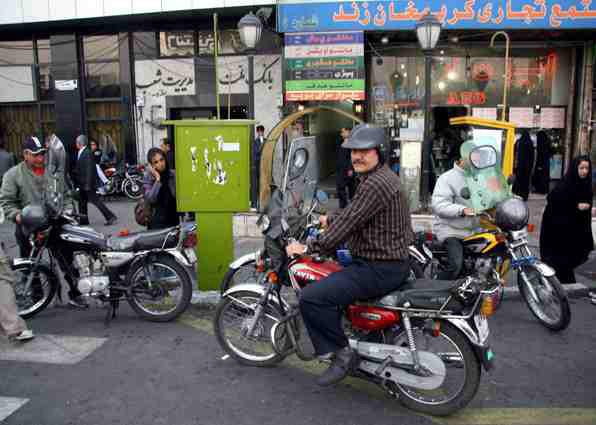
If you happen to find yourself on a Tehran avenue in the coming months, you may notice a passenger with a video camera in the backseat of a motorcycle taxi, interviewing the driver. Listen closely and you might catch a snippet of intense discussion over the purr of the bike’s motor. Wear something especially eye-catching that day, and you might even stand out in a frame of Tehran-based artist Shahab Fotouhi’s current video project, Third Case.
Third Case draws its subject, structure, and title from the 1979 film First Case, Second Case by Iranian auteur Abbas Kiarostami. Kiarostami’s film teases the allegorical implications out of a banal primary school incident in the context of the nascent Iranian Revolution. A teacher draws a large ear on a chalkboard. While his back is to the classroom, a student talks out of turn, disrupting the lesson. The teacher demands that the student identify himself, and when no one comes forward, he removes seven students from the class for further questioning. The film then presents two scenarios — cases, as it were — one in which the students refuse to name the guilty party and are all punished by being kept out of the classroom, and another in which one student identifies the culprit and is allowed to rejoin the class. Kiarostami interwove these two staged scenes with documentary footage of interviews in which he fielded reactions to the two cases from various adults, including newly minted officials of the revolutionary government. Many of the respondents Kiarostami engaged read the scenarios as parables of loyalty, condemning collaboration with the Shah’s secret police and pitting the nobility of silence against the weakness of informing, a reading which was undoubtedly aided by the conspicuous, slightly surreal, image of the ear on the board, drawn by the most potent authority figure in the film. (In spite of these anti-Shah interpretations, the film was banned by the new regime for its allegedly subversive content and for representing the opinions of figures from banned political organizations, such as the Communist Party.)
As his title suggests, Fotouhi’s Third Case presents a new option. Following a logic of substitution, he proposes the very same ethical classroom scenario, dramatized in First Case, Second Case, to motorcycle taxi drivers ferrying him around the city of Tehran. “The working class can give more interesting answers,” Fotouhi recently told me. “And after thirty years of transformations in society, these answers are more complicated.” Third Case doesn’t introduce a new scenario into the ethical dilemma, but instead reconfigures the terms of the documentary itself. In revisiting Kiarostami’s film and looking to workers such as taxi drivers, instead of politicians with big names spouting official discourse, Fotouhi is endeavoring to produce a remake in the strongest sense of the word — a work that is both a picture of the present in all its ambiguities and a trenchant critique of the past. By reassessing the binary logic and revolutionary clarity that structure Kiarostami’s film, Third Case promises to confront the predictability of the original film’s responses with the volatile contingencies of class, history, and public space — thus providing a framework for the political anxieties of Iranians today.
While the choice to restage the interviews on motorcycles certainly recalls signature moments from Kiarostami’s later films — Mohsen Makhmalbaf giving his imposter, Hossain Sabzian, a ride on the back of his two-wheeler in the closing scene of Close-Up; the haunting tracking shots filmed from the automobile of the suicidal figure in Taste of Cherry; and the entirety of Ten, which is shot in a car navigating Tehran — Fotouhi insinuates that Third Case is a critique of First Case, Second Case, and the “romantic” attitudes of that time. One could say that because the turn toward everyday people and vehicular shooting in Third Case comes from the neorealism of Kiarostami’s own oeuvre, the critical logic is inherent to the material and therefore even more potentially incisive. Moreover, the motorcycle taxi allows Fotouhi to be in “the same position as the audience of the work,” a position he has identified as crucial to his practice. Although he’s holding the camera, he’s a passenger on his own shoot, ceding much of the direction to notoriously “crazy” drivers. I imagine (as I watch YouTube videos of motorcycle taxi rides through Tehran) that some of the substance of these interviews will be lost or at least overwhelmed by the sheer visceral quality of a camera whipping through Tehran’s bustling streets. This strategy seeks to emphasize that “the question itself and the form of the film is more important than the responses.” It is difficult not to think back to the sound problems that obscure and mute much of the highly anticipated dialogue between Makhmalbaf and Sabzian on their bike ride in Close-Up.
Perhaps that is part of the point. Fotouhi’s 2008 video And All of a Sudden We Found a Path to the Waterfall Again intentionally disrupts the convention of sync sound as the artist confronts Mahmoud Ahmadinejad, mayor of Tehran at the time of filming, in handheld, claustrophobic, and physically agitated closeup. As Fotouhi visibly works to appear in the frame with Ahmadinejad and engage him amidst a throng of people, with all the sound removed, we’re left wondering about the nature of the encounter. Precisely for its lack of information, its refusal to state a clear political agenda, and its insistence on occupying time, this video, on completion, was a glimpse of power lying in wait.
Fotouhi plans on continuing to hail motorcycle taxis until he has enough footage to match the running time of First Case, Second Case. He tells me that he will also be shooting static shots of the drivers waiting to pick up fares, to intercut with the interviews. “Iranians are waiting for something to come,” he says. “Israeli bombs? A new president? We don’t know.”